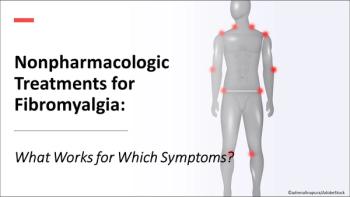
Patients with rheumatoid arthritis and fibromyalgia were at the greatest risk of transitioning to long-term opioid use 1 year after a first prescription, a new study found.

Patients with rheumatoid arthritis and fibromyalgia were at the greatest risk of transitioning to long-term opioid use 1 year after a first prescription, a new study found.

In a study of adults with pain in at least 1 body region, those with fibromyalgia had significantly greater odds of acknowledging pain-related addiction exacerbations.

Is acupuncture effective in reducing pain? Can exercise help patients with fibromyalgia sleep better? New systematic review and meta-analysis provides insight.

SAMPLE: Based on current research, what is the prevalence of fibromyalgia in the general population? Plus 11 more questions on fibromyalgia and chronic pain.

Chronic pain affects more Americans than diabetes mellitus, heart disease, and cancer combined. Here are some facts and figures about pain for you to consider.

An obese woman in her thirties with a history of fibromyalgia syndrome, depression, polycystic ovarian syndrome, and diabetes mellitus presents to her local emergency department with 1 week of gradually worsening midline back pain.

Change your name. Don't friend patients. Delete your Facebook account. This is official social media advice for today's medical students and physicians. What fuels physician Facebook phobia?

We have long known that many adolescents have chronic pain. A new study highlights just how widespread it is-and the significant impact it can have.


Twenty years ago, the American College of Rheumatology (ACR) introduced the following clinical criteria for the diagnosis of fibromyalgia (FM) . . .

The treatment of chronic fatigue syndrome (CFS) is mainly supportive. The key to effective management is to establish a therapeutic alliance with patients and to convey a consistent message that their complaints are taken seriously. Although spontaneous recovery is rare, it does occur in some patients with CFS.

Chronic fatigue syndrome (CFS) is a distinct disorder characterized by debilitating and often recurrent fatigue that lasts at least 6 months but more frequently lasts for longer periods. Patients with CFS experience overall physical, social, and mental impairments and may subsequently qualify for medical disability.

How to determine whether opioids are appropriate, what to do about breakthrough pain, and how frequently to monitor.

A study of Humana members enrolled in commercial and Medicare Advantage plans showed that patients with fibromyalgia have higher health care utilization and costs than those without the disease.1 This is because of higher use of office visits, testing, and procedures as well as pain-related medications.

An estimated 5 million US adults, or about 2% of the adult population, have fibromyalgia (FM), according to 2005 data collected by the National Arthritis Data Workgroup (Figure 1). FM is a chronic condition of unknown etiology characterized by widespread muscle pain, sleep disturbance, fatigue, and often psychological distress and is considered a form of arthritis. The workgroup also reported that the only study on the prevalence of primary FM in the United States-which included 3006 adults 18 years and older-showed that prevalence was significantly higher among women than among men (3.4% vs 0.5%; approximately a 7:1 ratio). In women, prevalence of the condition rose sharply in middle age, to 7.4% among those aged 70 to 79 years, and then declined. Prevalence of FM in men similarly peaked between 70 and 79 years but was only slightly more than 1% among men in this age-group. The CDC notes that the condition can also develop in children.

Clinicians often override electronic medication safety alerts, according to study findings published in the February issue of the Archives of Internal Medicine, indicating that such systems need to be more selective to be truly useful.

The numerous symptom domains of fibromyalgia syndrome (FMS) include pain, fatigue, sleep disturbance, mood disturbance, function impairment, irritable bowel syndrome, tension and migraine headache, and cognitive dysfunction. Its pathophysiology is rooted in neural dysregulation in the spinal cord and brain.

An estimated 46.4 million US adults, or approximately 21% of the adult population, self-reported a physician-diagnosed form of arthritis, which is the leading cause of disability in the United States, according to 2005 data collected by the National Arthritis Data Work group. The work group estimates that by 2030, the number of US adults aged 18 years and older with arthritis or other rheumatic conditions will jump to nearly 67 million (25% of the adult population)-an increase of about 40% (Figure 1).

ATLANTA -- On the eve of World Arthritis Day 2007, the CDC has released a snapshot, taken in 2003, of the burden of arthritis in the working world.

BALTIMORE -- Patients with rheumatoid arthritis who meditated were measurably less stressed after six months than those given standard care, but the disease was no better, said investigators here.

ANN ARBOR, Mich. -- The reason that opioids seem to fizzle for fibromyalgia may be because of reduced receptor activity in regions of the brain that process and dampen pain signals, researchers here found.

EXETER, England -- Although millions are attracted to the notion that magnets relieve or prevent aches and pains, the preponderance evidence holds otherwise, found British researchers.

SAN FRANCISCO -- Joint or muscle pain or both prompted 13% of breast cancer patients enrolled in a trial comparing exemestane (Aromasin) with letrozole (Femara) to discontinue treatment, researchers reported here.

INDIANAPOLIS -- Pregabalin (Lyrica) just became the first medication approved by the FDA for fibromyalgia-related pain, but it may not work for everyone, so older treatments may still be useful.

ROCKVILLE, Md. -- The FDA has approved pregabalin (Lyrica) for the treatment of fibromyalgia, making it the first drug to earn this indication.